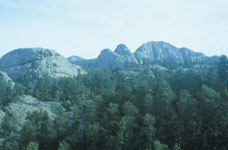What's at StakeApproximately 50,000 acres of potential wilderness remain in the Black Hills. The remote portions of these areas are the last sanctuary for old-growth forests - both ponderosa pine and spruce - in South Dakota. These areas provide the last opportunities to promote nonmotorized recreation such as backpacking and horsepacking on the forest. The Black Elk Wilderness addition and the Beaver Park area are the most pristine of the remaining roadless areas. Both shelter rare plant communities including spruce swamps, which have vegetation more similar to the Arctic than South Dakota. The ThreatsThe Forest Service's timber program is the biggest and most imminent threat to these areas. Logging companies are currently pressing hard to get into the old-growth stands located in the Black Elk Wilderness additions and the Beaver Park area. Off-road vehicle use is also a major problem. More than 8,000 miles of roads are located in the Black Hills, including little-used two-track roads in most of the proposed wilderness areas. The SolutionsThe Black Hills Group of the Sierra Club has been fighting the uphill battle to protect the forest for a quarter century. Wilderness protection is the best solution to save the last remaining roadless lands in the Black Hills. The Forest Service has been unwilling to protect them and the timber industry has used claims of beetle infestations and fire hazards - which biologists have refused to back - to pressure the agency to log these very special places. As an interim step, the Forest Service should recognize all of the Black Hills roadless areas as special areas in need of protection from logging and other intrusions. In addition, the Black Hills National Forest is ripe for restoration projects including closing roads and allowing native plants to return. Photo by Kirk Koepsel
| |||||||

